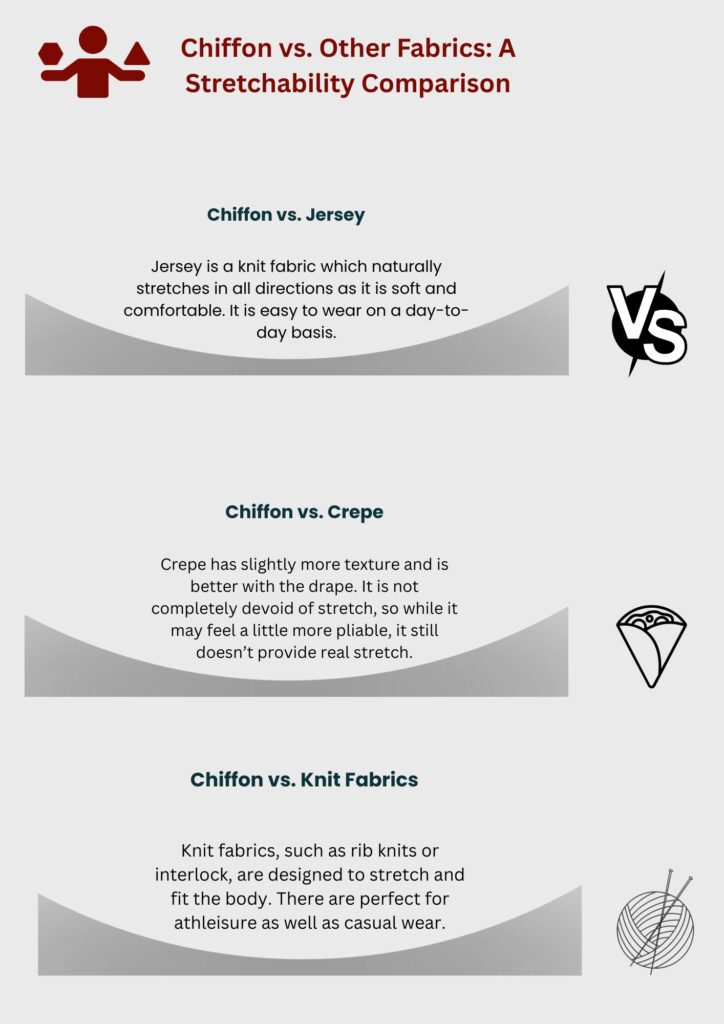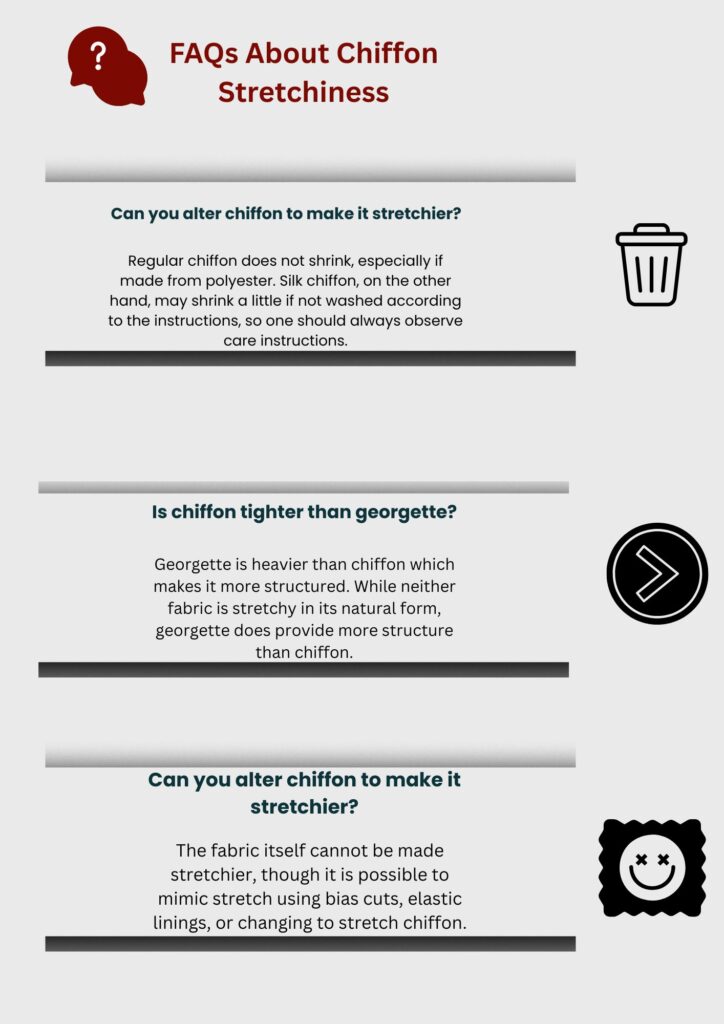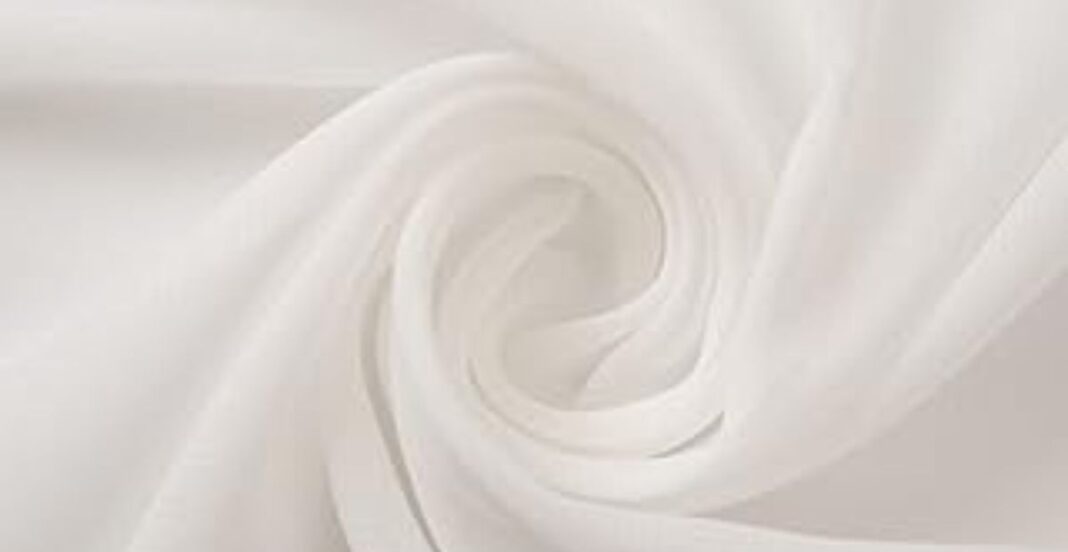Introduction
Chiffon has been a lightweight and airy fabric used in the fashion industry for decades. Fabric not only adds elegance but also gives a delicate look to garments because of its delicate appearance. is chiffon fabric stretchy?
Designers often use chiffon for dresses and bridal gowns, blouses, scarves, evening wear and even flowy cape like outfits. With chiffon, one can create layered styles because of its soft drape, subtle shimmer and soft shimmer
Chiffon fabrics differ in softness and breathability. Silk chiffon is the answer of broad elegance and expensive taste because it is often used in High – End Couture. Cheap and everyday consecutive option, Poly Chiffon is used more commonly in ready-to-wear garments. Finally, cotton chiffon is breathable and comfortable but less trendy than its counterparts, silk and poly.
Is Chiffon Fabric Stretchy? The Honest Answer
To answer briefly, no, chiffon as a traditional fabric does not have any stretch. Chiffon, as a weave-type fabric lacks its own stretchability because of the way it is constructed. The filaments are bound in a crisscross structure which offers no give when pulled.
Chiffon unlike jersey or spandex fabrics, does not contain elastic fibers like spandex or elastane. Because of this, chiffon is not pliable under tension and can tear if undue strain is applied.
The one exception to this is stretch chiffon. It retains much of the chiffon character but does offer some stretch and will slightly yield while still looking and feeling like chiffon. So the answer to the question, is chiffon fabric strtchy? , depends on the form of chiffon and its context.
Chiffon vs. Stretch Chiffon: What’s the Difference?
Let’s analyze how stretch chiffon and regular chiffon differ. Regular chiffon is made from silk, cotton or polyester, whereas stretch chiffon is a blend of polyester and spandex, having around 5-10% spandex added for stretch.
Regular chiffon is ‘stiff and flowy’ while stretch chiffon is ‘slightly horizontal stretchy.’ This slight give makes stretch chiffon perfect for the body-hugging style of bodycon dresses and fitted tops that require some comfort.
Regular chiffon is suitable for gowns, flowing dresses, and overlays. Stretch chiffon should be used for garments that require better fitting and freedom of movement. This practical difference will affect how each type is utilized in garment construction.
How to Make Chiffon More Stretchy?
For those who adore chiffon but require a little more ease, there are some options to look into. The first and the easiest to follow would be selecting stretch chiffon in place of the regular version. This form offers a bit of stretch while still maintaining some of the elegant drape.
Another trick would be to cut chiffon on the bias. This refers to cutting at the 45-degree angle to the weave of the fabric, and although chiffon is a woven fabric, it can give a slight internal stretch. While this isn’t a replacement for true stretch, it does provide some relief which will be helpful for ease while wearing or during sewing.
When it comes to chiffon, the order of sewing does matter. This is especially true for the sewing machine techniques used; French seams and rolled hems would work best when trying to prevent fraying to the edges that would lead to errant threads. The garment becomes streamlined, but it also has a non-tearable quality, which helps the fabric withstand tension.
Chiffon vs. Other Fabrics: A Stretchability Comparison
Understanding chiffon’s stretch limitations becomes easier when compared to how other fabrics work. Let’s examine how chiffon compares to:Chiffon Fabric Stretchy

Chiffon vs. Jersey
Jersey is a knit fabric which naturally stretches in all directions as it is soft and comfortable. It is easy to wear on a day-to-day basis. Chiffon, on the other hand, has non stretchy properties which makes it suitable for special occasion attires.
Chiffon vs. Crepe
Crepe has slightly more texture and is better with the drape. It is not completely devoid of stretch, so while it may feel a little more pliable, it still doesn’t provide real stretch. Chiffon is more delicate and sheer , making it better to achieve soft and airy looks.
Chiffon vs. Knit Fabrics
Knit fabrics, such as rib knits or interlock, are designed to stretch and fit the body. There are perfect for athleisure as well as casual wear. Chiffon, even in its stretch form, does not offer the same elasticity as a true knit.
Best Uses for Chiffon: Embracing Its Non-Stretch Nature
Chiffon is best used in garments that are unconfined and drape over the body due to lack of supportive structure. Fashion designers use chiffon extensively for making and designing maxi dresses, kaftans, evening gowns, and skirts which need to move gracefully rather than in a more rigid manner.
Chiffon is frequently used for overlays. This gives the garment an angelic and airy quality. Chiffon is also wonderful for the decorative parts of garments, such as flounces, gathers, or sashes where no form is needed.
Bridal and formal garments still remain most popular while using chiffon despite the fact that it lacks stretch. The materials’ gracefulness and wafting motion outweigh the absence of flexibility. This shows stretch isn’t always necessary to evoke enchantment.
Common Misconceptions About Chiffon Stretchiness
Due to the way chiffon moves so gracefully, many people inaccurately think that it has some level of stretch. This misconception is common.
Myth: “All chiffon has some stretch.”
Most varieties of chiffon do not contain spandex. Only a small number of silks labeled as stretch chiffon have that ability to expand. Thus, this is a misconception.
Myth: “Chiffon is like jersey or spandex.”
That is just another misconception.
Always check the label when buying chiffon. If it states something like 100% polyester, silk or cotton, then it most likely has no give at all. For stretch chiffon, look for a blend with a minimum of 5% spandex.
How to Care for Chiffon and Stretch Chiffon
Stretchy or non-stretch chiffon need special attention. Always hand wash in cold water or gentle machine wash using a mesh bag. Agitation or harsh detergents will damage the chiffon’s fibers and shorten its lifespan.
Gently hang or lay the garment flat to dry in order to avoid distortion. For stretch chiffon, do not over-stretch when wet because stubborn pulling is likely with the added spandex.
To de-wrinkle chiffon, use steam or a low-temperature iron. High temperatures can scorch polyester and silk chiffon fabrics.
Where to Buy Stretch Chiffon?
Many fabric shops, both physical and online, have stretch chiffon. Mood Fabrics, Joann, Fabric.com, and even Etsy for unique prints are well-known ecommerce sites.
While ordering, look at the composition of the fabric. A good stretch chiffon usually contains 90–95% polyester and 5–10% spandex. This ratio helps the fabric retain the fluffy chiffon features while providing some stretch.
Stretch chiffon collections from Telio, Robert Kaufman, and Michael Levine are some other brands that I frequently buy from. Always check reviews and order a sample for testing the stretch and drape to avoid purchasing large quantities without due testing.
FAQs
Regular chiffon does not shrink, especially if made from polyester. Silk chiffon, on the other hand, may shrink a little if not washed according to the instructions, so one should always observe care instructions.
The fabric itself cannot be made stretchier, though it is possible to mimic stretch using bias cuts, elastic linings, or changing to stretch chiffon.
Georgette is heavier than chiffon, which makes it more structured. While neither fabric is stretchy in its natural form, georgette does provide more structure than chiffon.
FAQs About Chiffon Stretchiness

Conclusion
Chiffon is known for its lightness, flow, and elegance which is why it is regarded as one of the most sophisticated fabrics—but it certainly lacks any form of flexibility.Traditional chiffon is devoid of elastic materials like spandex and therefore lacks elasticity. However, the fashion industry has introduced stretch chiffon, a smart alternative that blends polyester with elastane to provide some limited stretch while still like keeping chiffon’s graceful look.
chiffon fabric stretchy Making such enhancements becomes simple when you learn the difference between regular chiffon, and stretch chiffon, hence you can plan better for sewing and designing or shopping needs. Understanding how chiffon behaves will help you in creating stunning and functional garments like bridal gowns, dresses or even floaty scarves.


